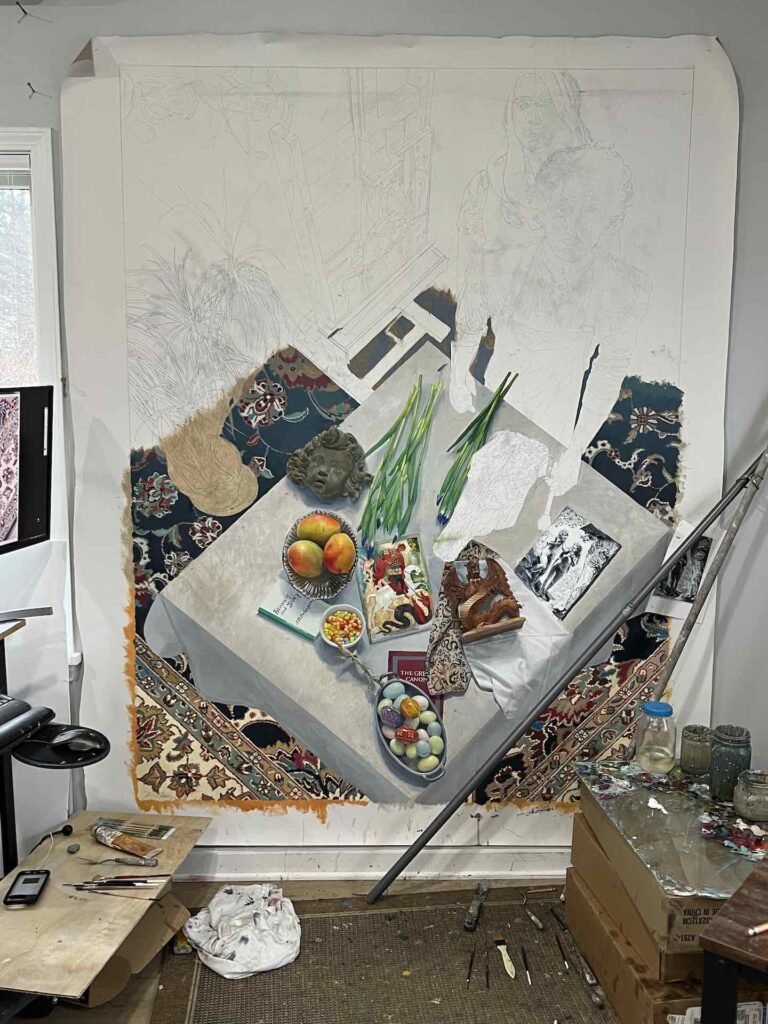There be dragons

George’s Dream in progress
I realized today that I haven’t posted here for nearly a season. I’ve been absorbed by the largest painting I’ve ever undertaken, a departure from almost everything I’ve done so far. I’m moving off the edge of the map of what I know how to do, and it’s both unsettling and exhilarating. It’s a one-off effort is how I look at it; I’m not seeing a series of paintings like this in my future. Oxford Gallery has a group show on the theme of dreams in April, and I’m hoping to finish this in time to have it in the show. It’s not the smartest thing to be doing right now, given the fact that my taffy paintings have been selling, but the opportunity emerged to put myself on a deadline and get this thing finished after thinking about it for the past couple years. I’d be smarter to do half a dozen more taffy paintings on the chance that Arcadia Contemporary will sell most of the work it shows at the LA Art Show next month. But if that work sells, I should be able to begin producing more work for Arcadia in March.
All of this has been going through my head: can I finish this big canvas in time for Oxford and will I be able to return to some taffy paintings without missing more than a beat or two when this one is finished? I think so, but wasn’t feeling it until this week when the still life portion began to look closer to completion. I’ve been so focused on the considerable demands of this painting that I’ve neglected the blog and Instagram and opportunities to have more fun than I deserve. I also have a solo show, a review of work from the past ten years, at SUNY Finger Lakes Community College coming up in a month. (As Spoon sings, everything hits at once.) I have more than enough work to provide for the show, candy jars from a decade ago, a sampling of still lifes over the years since then, and several taffy paintings that aren’t on their way to Los Angeles. That said, most of my time every day has been devoted to inching my way up from the bottom of this canvas to the top.
This work is a departure for me in that it’s intentionally meant to evoke a narrative. I’ve done tabletop paintings, gazing down from overhead on a square table covered with a white cloth, objects arranged randomly with more consideration for shape and color than anything else. They have suggested narratives to some of my friends, but that was never the intention. Like Chardin I tend to reuse familiar and favorite things in my still life paintings simply for their formal qualities, shape and color and so on: a cream pitcher, jelly beans, flowers from my garden or the supermarket, art books, CDs or mobile devices, patterned napkins. In this one the objects are chosen to serve as props for a painting about good and evil. They are under consideration by the painter who hasn’t been painted yet: his outline with the drawing of a woman standing behind him, appears behind the table on the right. Beside and slightly behind them, in the right/center, stands an easel with a painting of a human skull on the drawer than supports it. In the upper right corner, there’s a sketch of an angel I’ve quoted from Chagall’s huge painting where he depicts himself grinning, perched on his wife’s shoulders holding a wine glass to the sky. George’s Dream is about the painter who has yet to appear except as a line drawing. It’s a visualization of this painter’s dream, his assembly of objects to represent a modernization of that St. George and the Dragon legend. It’s up to the viewer to speculate on how the objects on the table figure into this project. The etching just below the painter’s hand is by Rembrandt, Adam and Eve in the garden, with the exchange of an apple in the offing, and in the upper corner of that print, there’s a dragon attaching himself to the tree trunk, looking as if he’s ready to pounce, more like Hobbes in the cartoon series than a dinosaur with bat’s wings.
I look forward to making a little, incremental progress on this image every day. Even the finished looking objects would benefit from more work. The Salinger book isn’t white enough where the light hits it. The etching is too white overall. There’s a blank space for a cow skull on the table. I’ve been indicating areas of flat color and then working on individual areas and object until they are finished. The tablecloth is just two areas of flat color at this point.
I have a backlog of little posts I’ve wanted to do about various other artists whose work I’ve seen since last October, and I’m hoping to get some quick observations off for a while now. I’m still finishing my fourth reading of Proust and my thoughts on that book could fill a book, but he is one of the greatest novelists for a painter to read, since he was influenced by a number of painters in his writing and much of what he says uses paintings as reference points and metaphors. His work is inexhaustibly intelligent, insightful and ultimately unique: what he was doing was spiritually radical in a way no one has really fully explored except for how Samuel Beckett touches on it in his long essay. More to come.
Comments are currently closed.